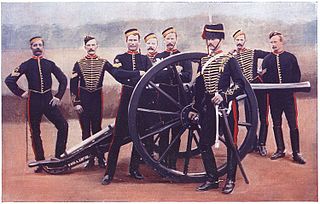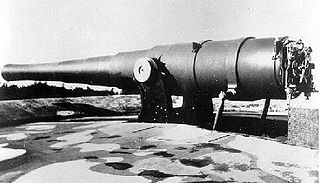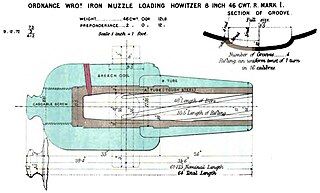This article explains terms used for the British Armed Forces' ordnance (weapons) and ammunition. The terms may have slightly different meanings in the military of other countries.

The Armstrong RBL 7-inch gun, also known as the 110-pounder, was an early attempt to use William Armstrong's new and innovative rifled breechloading mechanism for heavy rifled guns.

An Armstrong gun was a uniquely designed type of rifled breech-loading field and heavy gun designed by Sir William Armstrong and manufactured in England beginning in 1855 by the Elswick Ordnance Company and the Royal Arsenal at Woolwich. Such guns involved a built-up gun construction system of a wrought-iron tube surrounded by a number of wrought-iron strengthening coils shrunk over the inner tube to keep it under compression.

The Armstrong Breech Loading 12 pounder 8 cwt, later known as RBL 12 pounder 8 cwt, was an early modern 3-inch rifled breech-loading field gun of 1859.

The Ordnance BL 12-pounder 7cwt was the British Army's field gun, which succeed the RML 13-pounder 8 cwt in 1885.

The BL 9.2-inch Mk I–VII guns were a family of early British heavy breechloading naval and coast defence guns in service from 1881 to the end of World War I. They were originally designed to use the old gunpowder propellants.

The BL 6-inch gun Marks II, III, IV and VI were the second and subsequent generations of British 6-inch rifled breechloading naval guns, designed by the Royal Gun Factory in the 1880s following the first 6-inch breechloader, the relatively unsuccessful BL 6-inch 80-pounder gun designed by Elswick Ordnance. They were originally designed to use the old gunpowder propellants but from the mid-1890s onwards were adapted to use the new cordite propellant. They were superseded on new warships by the QF 6-inch gun from 1891.

The BL 6 inch gun Mk V was an early Elswick Ordnance Company breech-loading naval gun originally designed to use the old gunpowder propellants. They were used for coast defence around the British Empire.
The Armstrong RBL 40-pounder gun was introduced into use in 1860 for service on both land and sea. It used William Armstrong's new and innovative rifled breechloading mechanism. It remained in use until 1902 when replaced by more modern Breech Loading (BL) guns.

The RML 9-inch guns Mark I – Mark VI were large rifled muzzle-loading guns of the 1860s used as primary armament on smaller British ironclad battleships and secondary armament on larger battleships, and also ashore for coast defence. It should not be confused with the RML 9-inch Armstrong Gun, used by the Dutch navy, the Spanish Navy, and other navies.

The RML 64-pounder 71 cwt guns (converted) were British rifled muzzle-loading guns converted from obsolete smoothbore 8-inch 65 cwt shell guns in the 1860s-1870s.

The BL 6-inch 80-pounder gun Mk I was the first generation of British 6-inch breechloading naval gun after it switched from muzzle-loaders in 1880. They were originally designed to use the old gunpowder propellants.

The 68-pounder cannon was an artillery piece designed and used by the British Armed Forces in the mid-19th century. The cannon was a smoothbore muzzle-loading gun manufactured in several weights, the most common being 95 long cwt (4,800 kg), and fired projectiles of 68 lb (31 kg). Colonel William Dundas designed the 112 cwt version in 1841 and it was cast the following year. The most common variant, weighing 95 cwt, dates from 1846. It entered service with the Royal Artillery and the Royal Navy and saw active service with both arms during the Crimean War. Over 2,000 were made and it gained a reputation as the finest smoothbore cannon ever made.

The RML 7-inch guns were various designs of medium-sized rifled muzzle-loading guns used to arm small to medium-sized British warships in the late 19th century, and some were used ashore for coast defence.

The RML 40-pounder gun was a British rifled muzzle-loading siege and fortification gun designed in 1871. It was intended to supersede the RBL 40-pounder Armstrong gun after the British military reverted to rifled muzzle-loading artillery until a more satisfactory breech-loading system than that of the Armstrong guns was developed.
The ML 8 inch shell guns of 50 cwt, 54 cwt and 65 cwt were the three variants of British cast iron smoothbore muzzle-loading guns designed specifically to fire the new generation of exploding shells pioneered in the early-mid nineteenth century by Henri-Joseph Paixhans.

The RML 9-pounder 8 cwt gun and the RML 9-pounder 6 cwt gun were British Rifled, Muzzle Loading (RML) field, horse and naval artillery guns manufactured in England in the 19th century, which fired a projectile weighing approximately 9 pounds (4.1 kg). "8 cwt" and "6 cwt" refers to the weight of the gun to differentiate it from other 9-pounder guns.

The RML 16-pounder 12 cwt gun was a British Rifled, Muzzle Loading (RML) field artillery gun manufactured in England in the 19th century, which fired a projectile weighing approximately 16 pounds (7.3 kg). "12 cwt" refers to the weight of the gun.

The RML 8-inch howitzer was a British Rifled, Muzzle Loading (RML) Howitzer manufactured in England in the 19th century, which fired a projectile weighing approximately 180 pounds (82 kg). It was used in siege batteries and in fortifications.
The RML 25-pounder gun was a British rifled muzzle-loading light siege gun and gun of position designed in 1871. It was intended to be an intermediate gun between the 16-pounder and 40-pounder Rifled Muzzle Loading guns. It was part of a series of guns designed after the British military reverted to rifled muzzle-loading artillery until a more satisfactory breech-loading system than that of the Armstrong guns was developed.
















